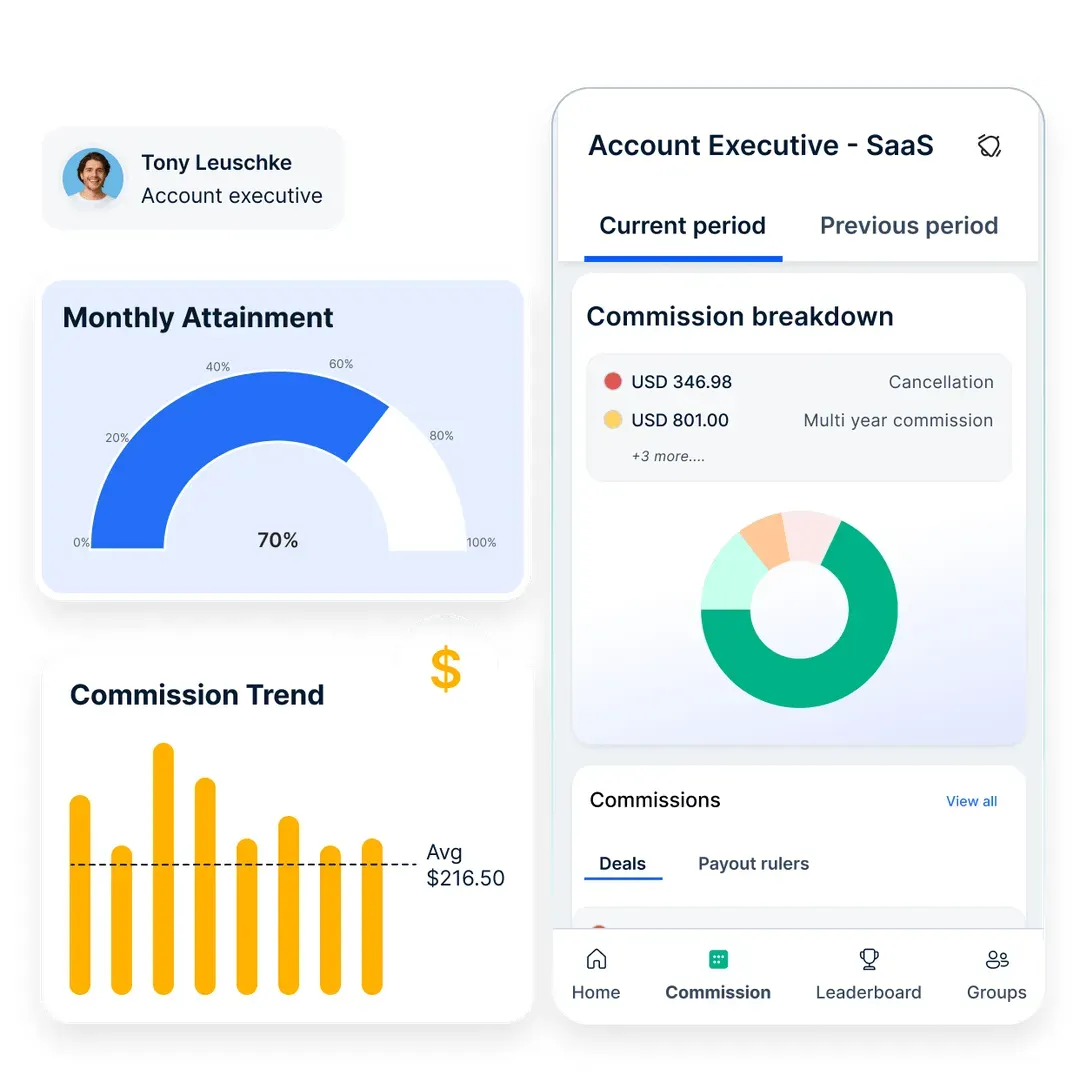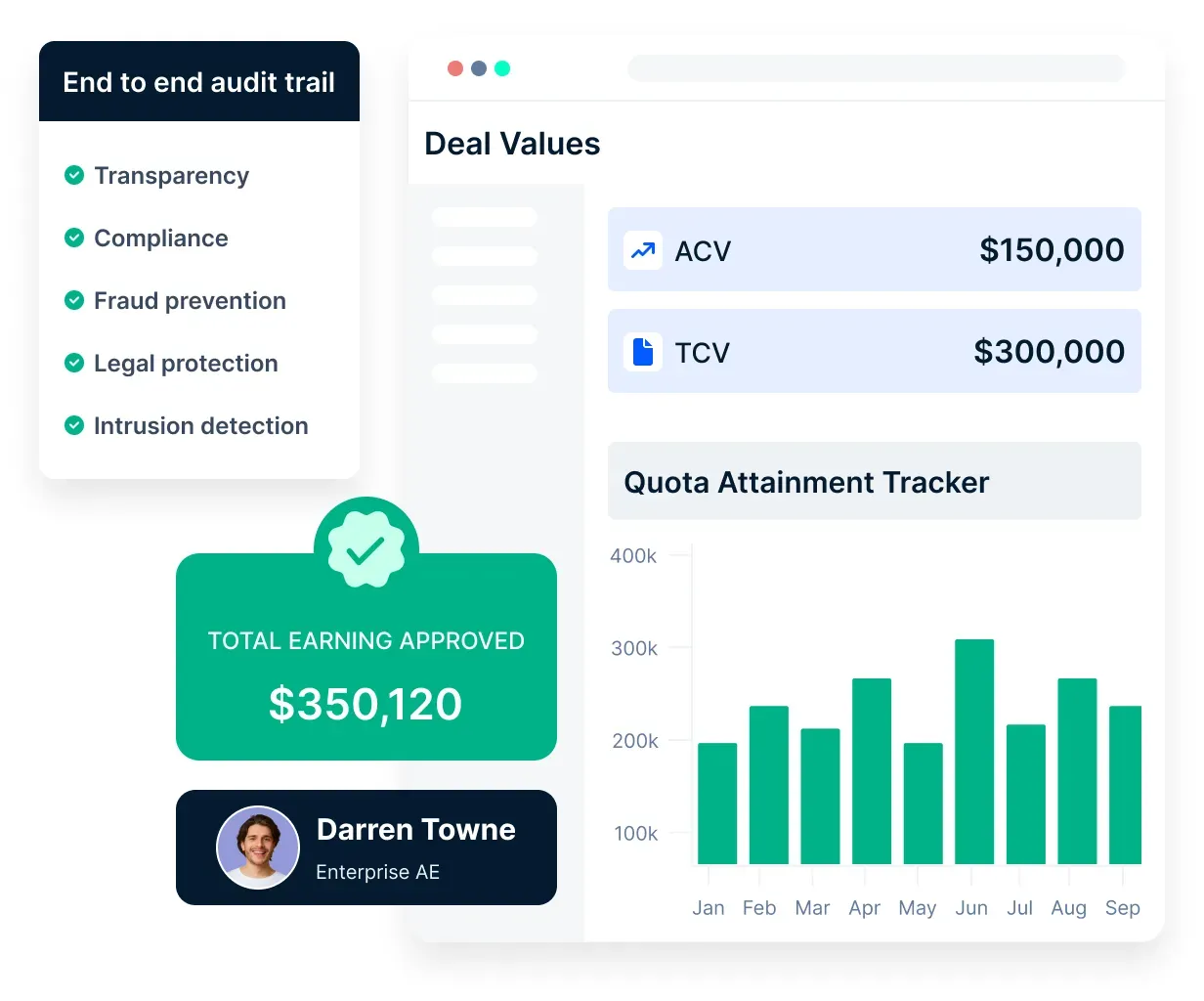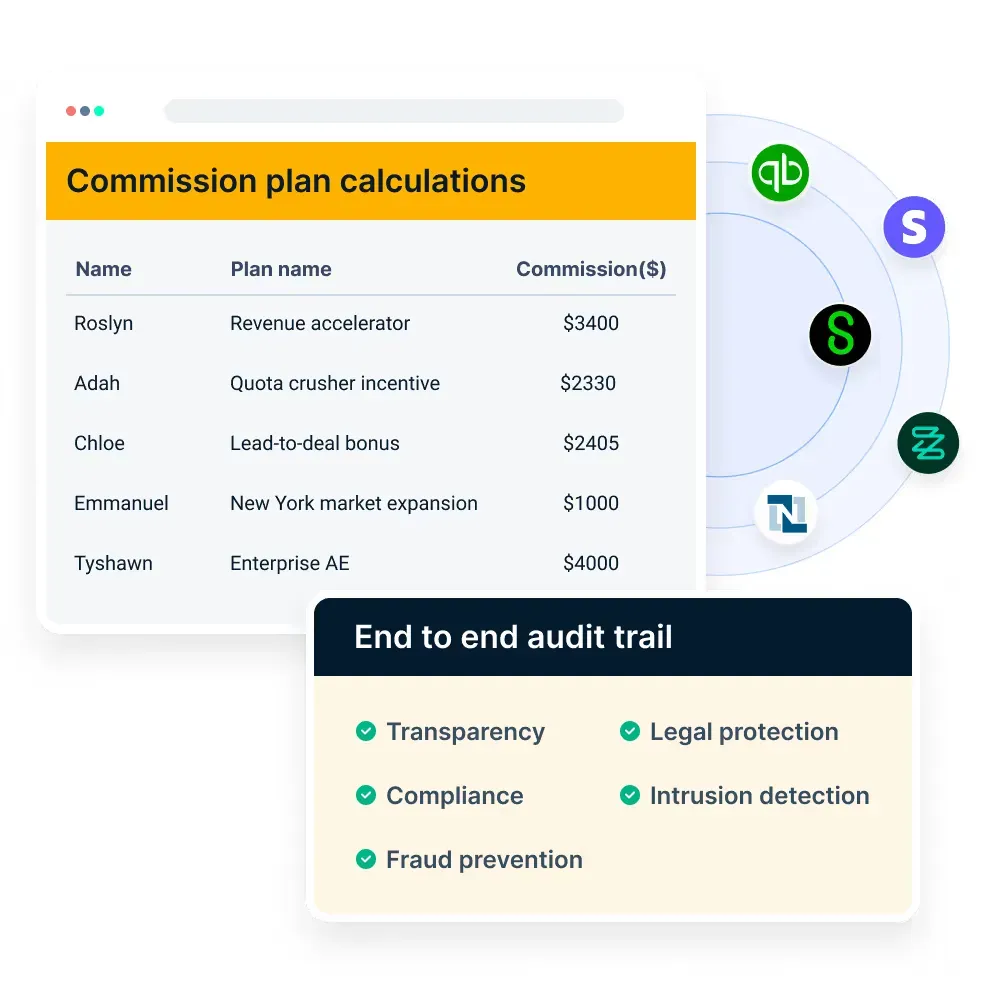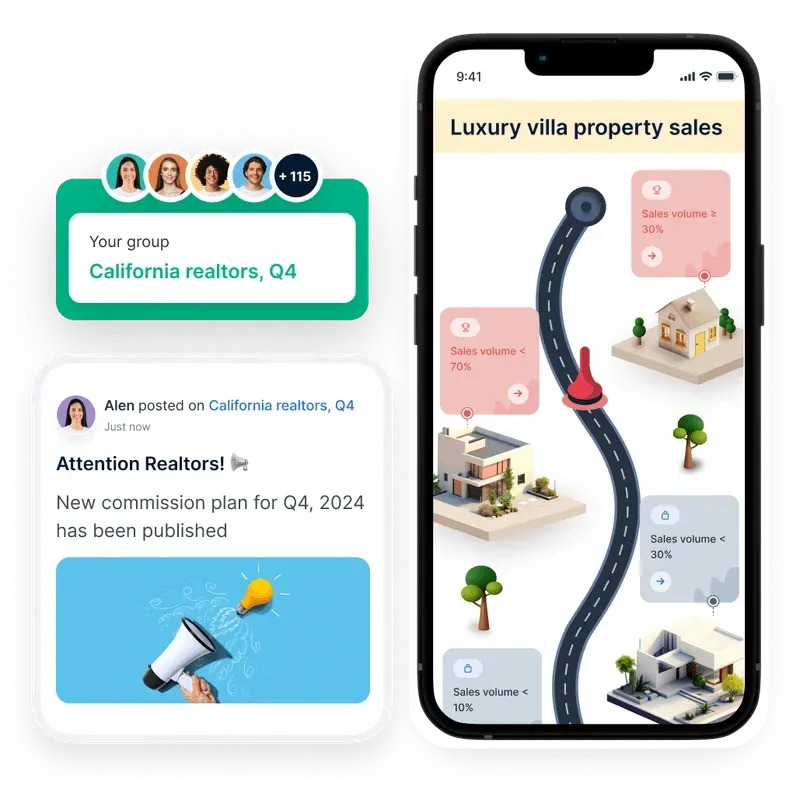إدارة أداء المبيعات بشكل صحيح: مخطط لنمو المبيعات
إن عملية إدارة أداء المبيعات القوية تُبقي فرق العمل على المسار الصحيح، وتحقق الأهداف، وتدفع عجلة النمو. يغطي هذا الدليل تحديد الأهداف، والتتبع، والتدريب، والحوافز لمساعدة الشركات على بناء استراتيجية فعالة وقابلة للتطوير للتحسين المستمر.
في هذه الصفحة
تحقق المؤسسات التي تستخدم إدارة الأداء الاستراتيجي 3 أضعاف نمو الإيرادات السنوية مقارنةً بتلك التي لا تستخدمها.
اتجاه رئيسي في مشهد المبيعات الحالي, إدارة أداء المبيعات أو SPM، هو نظام مبتكر لإدارة المبيعات يستخدم أدوات الجيل التالي وأفضل الممارسات القائمة على البيانات لتحقيق نتائج مبيعات متفوقة. من خطة استراتيجية المبيعات إلى الهيكل التنظيمي يتم تحسينها في إطار إدارة أداء المبيعات لتزويد الشركة بميزة تنافسية مستدامة في السوق.
ولا يمكن المبالغة في أهميتها. وفقًا لـ InsightSquared 81% من أعضاء فريق المبيعات في المؤسسات التي تبنت إدارة الأداء الاستراتيجي يحققون أهداف المبيعات الخاصة بهم، مقارنةً بنسبة 25% في المؤسسات المتأخرة. كما سجلت الشركات الأولى أيضًا 3x نموًا سنويًا في الإيرادات مقارنةً بالشركات المتأخرة. هذا يكفي.
إذا كنت تتساءل عن كيفية تطبيق إدارة أداء المبيعات (SPM) في مؤسستك، تابع القراءة!
ما هي إدارة أداء المبيعات (SPM)؟
تُعد إدارة أداء المبيعات (SPM) نهجًا استراتيجيًا يساعد المؤسسات على تتبع أداء المبيعات وتحليله وتحسينه من خلال تحديد الأهداف والتغذية الراجعة في الوقت الفعلي والرؤى القائمة على البيانات. وهو يضمن استمرار تحفيز فرق المبيعات ومواءمتها مع أهداف العمل وتحسين نتائجها باستمرار.
المكونات الرئيسية لإدارة أداء المبيعات:
- تحديد الأهداف وتتبع الأداء: وضع أهداف مبيعات واضحة وقابلة للقياس ومراقبة التقدم المحرز في الوقت الفعلي.
- إدارة تعويضات الحوافز: تصميم هياكل العمولات والمكافآت والمكافآت وإدارتها لتحفيز الحوافز.
- التدريب والتدريب على المبيعات: توفير التغذية الراجعة المستمرةوتطوير المهارات والإرشاد لتحسين الأداء الفردي والجماعي.
- اتخاذ القرارات المستندة إلى البيانات: الاستفادة من التحليلات لتحديد الاتجاهات وتحسين الاستراتيجيات وتحسين عمليات المبيعات.
- التلعيب والمشاركة: استخدام لوحات المتصدرين ومسابقات المبيعات وبرامج التقدير لتعزيز التحفيز والمنافسة الصحية.
من خلال تنفيذ استراتيجيات إدارة الأداء الاستراتيجي، يمكن للشركات إنشاء ثقافة مبيعات عالية الأداء، وتحسين تحقيق الحصص وزيادة نمو الإيرادات. 🚀
عملية تنفيذ نظام إدارة أداء المبيعات
فيما يلي كيفية تنفيذ نظام إدارة أداء المبيعات بنجاح، بما يضمن تحقيق أهداف واضحة، وتتبع مبسط، وتحسين أداء الفريق.
1. تحديد المقاييس التي تريد قياسها
يجب أن تعكس مقاييس الأداء التي تقيسها كجزء من نظام إدارة الأداء الاستراتيجي الخاص بك تركيز مقاييس نجاح مؤسستك. وفيما يلي بعض المقاييس التي يمكنك التفكير في قياسها:
مقاييس إنتاجية المبيعات
تقيس هذه الكفاءة التي يمكن لمندوبي المبيعات من خلالها الوصول إلى أهدافهم. كلما أسرعوا في الوصول إلى أهداف مبيعاتهم ، زادت إنتاجية مبيعاتهم. بعض المقاييس التي يجب قياسها هنا هي:
- النسبة المئوية للساعات التي يقضيها التنقيب
- النسبة المئوية للساعات التي يقضيها في المهام الإدارية
- النسبة المئوية للصفقات المغلقة التي أدت إلى المبيعات
معدل التحويل
يشير هذا المقياس إلى النسبة المئوية للعملاء المحتملين الذين تم تحويلهم إلى عملاء من قبل كل مندوب مبيعات. وهو يزودك بمعلومات حول جودة العملاء المحتملين وما إذا كانت المؤسسة لديها الموارد الكافية لرعايتهم وتحويلهم إلى عملاء محتملين.
بلوغ الحصص
تحقيق الحصة النسبية أو تحقيق الحصة الفردية هو مقياس للنسبة المئوية لهدف المبيعات التي وصل إليها كل مندوب مبيعات خلال فترة زمنية. يساعد هذا المقياس في قياس الأداء ، أي أن فهم الأهداف التي حددتها لفريق المبيعات الخاص بك عدوانية للغاية أو سهلة للغاية أو صحيحة تماما.
2. احصل على موافقة فريق المبيعات الخاص بك
يعد توصيل أهدافك إلى فريقك والحصول على موافقتهم على المقاييس التي سيتم تقييمهم على أساسها أمرًا أساسيًا لعدة أسباب. أولاً، إذا شعر فريقك أنه جزء من عملية تحديد الأهداف، فإن ملكيتهم للأهداف ستكون أعلى بكثير.
ثانيًا، من الضروري التواصل الواضح وغير الملتبس للأهداف التي تضعها في ذهنك لفريقك قبل أن يصل جنودك إلى ساحة المعركة! تذكّر أن تسمح لفريقك بالتعبير عن أي مخاوف قد تكون لديهم وحتى أن يتراجعوا عن ذلك إذا اختاروا ذلك.
على سبيل المثال، قد يشعر فريقك أن بعض الأهداف عدوانية أكثر من اللازم أو أن قياس بعض مجالات الأداء غير مناسب. بمجرد أن يعبروا عن مخاوفهم، يمكنك اتخاذ أحد مسارين من الإجراءات - تصحيح المسار وتغيير المقاييس التي ستستخدمها أو مساعدة فريقك على فهم كيفية ارتباط هذه الأهداف والمقاييس بالأهداف التنظيمية.
قد يكون من المفيد أيضا إشراك فريق المبيعات الخاص بك في عملية تحديد الأهداف من البداية ، مما يؤدي إلى ملكية أعلى.
3. تطوير مهارات تحسين أداء فريق المبيعات لديك
الآن بعد أن حددت المقاييس التي ستقوم بتتبعها وحصلت على موافقة فريقك عليها ، فقد حان الوقت للتأكد من أن مندوبي المبيعات لديهم المهارات والموارد المناسبة لتحقيقها. تتمثل إحدى الطرق الفعالة للقيام بذلك في السماح لفريقك بتكبير المهارات التي يريدون تحسينها ثم الاستفادة من هذا الاهتمام المتأصل لبناء المهارات التي يحتاجونها لتحقيق الأهداف التنظيمية. يمكنك بعد ذلك استخدام طرق مثل تقديم أدوات التدريب لهم ، أو تقديمهم إلى الموجهين ، أو حتى زميل قد يكون لديه مهارات ممتازة في المنطقة لإنجاز المهمة.
4. تقديم ملاحظات منتظمة لأعضاء فريق المبيعات الفردية
لتتبع ومراقبة أداء فريق المبيعات الخاص بك ، تعد هذه الخطوة الأخيرة المتمثلة في تزويدهم بتعليقات مخصصة أمرا مهما. يتضمن الاستعراض الشامل للأداء ما يلي:
- أداء عضو فريق المبيعات حول الأهداف الموثقة التي يتم تقييمها من أجلها
- يتم اتخاذ تحسينها أو الإجراءات على أساس الجولات السابقة من ردود الفعل
- نجاحاتهم ونقاط القوة التي لديهم والتي مكنت هذه النجاحات
- ردود فعل بناءة حول المجالات التي توفر مجالا للتحسين
- ملخص شامل لأدائهم بناء على ما إذا كانوا قد استوفوا التوقعات أو لم يلبوها أو تجاوزوها
مكونات إدارة أداء المبيعات
فيما يتعلق بإدارة أداء المبيعات، قد يكون من المقنع طرح الأسئلة القديمة الجيدة التي تتمحور حول حروف الواو والهاء الأربعة، أي ماذا تبيع، وأين تبيع، وكيف تبيع.
1. تخطيط المبيعات (مكان البيع)
يمكن أن يؤدي سوء تخطيط المناطق والحصص إلى استنزاف المبيعات بسرعة - وهي مسألة مكلفة لأي مؤسسة. للحماية من هذا الأمر وغيره من العواقب السلبية، مثل ضعف معنويات الموظفين، فإن تخطيط المبيعات هو أداة فعالة لإدارة أداء المبيعات.
إنه ينطوي على تقسيم السوق من خلال تجزئة الحساب ، وتحديد الحصص ، وتخطيط السعة ، وتخصيص الأراضي ، يليه مواءمة الفريق ليناسب هذا التجزئة.
2. حوافز المبيعات (كيفية البيع)
يمكن الاستفادة من هياكل الحوافز لتصحيح مسار عمل فريق المبيعات بالطرق المرغوبة. تسمح أفضل هياكل الحوافز بتعظيم الأرباح الفردية وتعزيز النتيجة النهائية للشركة.
قد يكون من المفيد الحفاظ على هياكل العمولة مرنة لتتمكن من دمج تغييرات السوق بسرعة. ومع ذلك، من المهم أيضاً عدم تغييرها في كثير من الأحيان بحيث تترك مندوبي المبيعات في حيرة من أمرهم.
3. رؤى المبيعات أو ما تبيعه
تلتقط برامج إدارة أداء المبيعات المتقدمة الآن البيانات من جميع أنحاء مؤسسة المبيعات ثم تقدم الرؤى المناسبة لمختلف أصحاب المصلحة. يمكن لقادة المبيعات استخدام هذه الرؤى لتقديم تحسينات كبيرة على جميع مقاييس المبيعات، بما في ذلك متوسط حجم الصفقات والصفقات التي تم إبرامها وغير ذلك.

تعزيز أداء المبيعات باستخدام رؤى مدعومة بالذكاء الاصطناعي
تمنحكCompass تحليلات في الوقت الفعلي، وحوافز تلقائية، وألعاباً لتعزيز إنتاجية المبيعات. تتبع التقدم، وحسِّن الاستراتيجيات، وحافظ على تفاعل فريقك - كل ذلك في منصة واحدة.
ابدأ التحسين اليوم
أنواع أساليب إدارة المبيعات
كما يشير ستيف دبليو مارتن في مجلة هارفارد بيزنس ريفيو في مجلة هارفارد بيزنس ريفيو إلى أن هناك بشكل عام سبعة أنماط مختلفة لإدارة المبيعات، يتوافق كل منها مع نمط سلوكي معين.
1. الموجهون
محركات مهمة لنجاح المبيعات ، يمثل الموجهون فئة قادة المبيعات الذين هم خبراء مبيعات ويقيسون نجاحهم من خلال أهداف الإيرادات التي تم تحقيقها أو تجاوزها بالإضافة إلى نجاح أعضاء فريق المبيعات الفردي.
2. التعبيرية
ماهر في إدارة الأفراد ولديه مهارة للتعبير عن مشاعرهم وتشجيع الآخرين على فعل الشيء نفسه ، فإن التعبيرات لها ميل لتهدئة فريقهم وتوبيخهم حسب ما يتطلبه الموقف.
3. الرقباء
مع لقب مستمد من اللغة العسكرية (ولسبب وجيه!) ، فإن الرقباء هم عمال مجتهدون "يحشدون قواتهم" أو يدفعونهم للعمل بجدية أكبر بينما يظهرون في نفس الوقت مستوى عال من الولاء لفريقهم ، وأحيانا ينافسون ما يظهرونه تجاه المنظمة.
4. التفلون
يمتلك التيفلون تصرفا لطيفا ومقبولا ، وهم ماهرون في البقاء فوق السياسة اليومية في أماكن العمل. ومع ذلك ، فإنهم عادة لا ينجحون في تكوين علاقات وثيقة مع أعضاء فريقهم.
5. المدراء الجزئيون
يتوقع المديرون الجزئيون ، المنهجيون والمنظمون للغاية ، نفس الشيء من أعضاء فريقهم ويطالبون بإنجاز الأمور على طريقتهم. إن إحساسهم بالمسؤولية تجاه مؤسساتهم قوي ، وهم يفخرون بتحقيق أهداف إيراداتهم.
6. الإفراط في الاحتيال
استثنائي في مكالمات المبيعات واجتماعي في الأماكن العامة ، عادة ما يتم إغلاق الثقة المفرطة أمام التعليقات وسينجزون المهمة بأي ثمن ، ويقومون بالأشياء بطريقتهم الخاصة.
7. الهواة
الهواة هم مديرو مبيعات ليسوا بالضرورة جددا في الدور ولكنهم يجدون أنفسهم خارج منطقة الراحة الخاصة بهم فيه. عادة ما يجدون أنفسهم في أزمة هوية حتى يتمكنوا من اكتساب خبرة مبيعات كافية وتحسين لعبتهم.
دور إدارة أداء المبيعات في المساءلة
يضمن وجود إطار عمل قوي لإدارة أداء المبيعات (SPM) أن فرق المبيعات لا تفي بالتوقعات فحسب، بل تتجاوزها أيضًا، خاصةً في بيع برامج إدارة ممارسات الأمراض الجلدية. أكثر من مجرد تتبع المقاييس، فإن إدارة أداء المبيعات تعزز ثقافة المساءلة حيث يتحمل كل عضو من أعضاء الفريق - مندوبي المبيعات وموظفي الدعم على حد سواء - مسؤولية تأثيرهم.
تشمل العناصر الرئيسية لإدارة الأداء الاستراتيجي ما يلي:
✅ أهداف واضحة تتماشى مع أهداف العمل.
✅ التغذية الراجعة في الوقت الفعلي لتعزيز النجاح ومعالجة التحديات.
✅ رؤى قائمة على البيانات من أجل التحسين المستمر للأداء.
من خلال دمج هذه الاستراتيجيات، تنشئ المؤسسات ثقافة مبيعات شفافة وعالية الأداء حيث تؤدي المساءلة إلى المشاركة والعمل الجماعي والنجاح القابل للقياس. إن إدارة الأداء الاستراتيجي ليست مجرد استراتيجية، بل هي أساس قوة المبيعات المتحمسة والقائمة على النتائج.
استراتيجيات تعزيز المساءلة من خلال إدارة أداء المبيعات
فيما يلي الاستراتيجيات التالية لتعزيز المساءلة من خلال آلية التخطيط الاستراتيجي:
1. وضع توقعات واضحة
أساس المساءلة هو التوقعات الواضحة. يجب على قادة المبيعات توصيل أهداف المؤسسة وغاياتها، وتحديد شكل النجاح، ووضع أهداف واضحة وقابلة للتحقيق لكل عضو من أعضاء الفريق. وينبغي أن تكون هذه التوقعات محددة وقابلة للقياس وقابلة للتحقيق وذات صلة ومحددة زمنياً لتوفير اتجاه واضح وتسهيل تتبع التقدم المحرز.
2. تنفيذ تتبع الأداء الشفاف
تسمح الشفافية في تتبع الأداء لممثلي المبيعات بمعرفة موقفهم من أهدافهم وكيف تساهم جهودهم في تحقيق أهداف المؤسسة. يمكن أن يوفر استخدام برنامج إدارة الأداء الاستراتيجي رؤية في الوقت الفعلي لمقاييس المبيعات، مما يسهل على المديرين وفرقهم مراقبة التقدم المحرز ومعالجة التحديات على الفور.
3. تقديم ملاحظات بناءة
تعتبر التغذية الراجعة عنصرًا حاسمًا في إدارة الأداء والمساءلة. تساعد الملاحظات المنتظمة والبناءة مندوبي المبيعات على فهم نقاط قوتهم ومجالات التحسين. يجب أن تكون محددة وقابلة للتنفيذ وتركز على السلوكيات والاستراتيجيات التي يمكن تغييرها أو تحسينها. كما أن جلسات التغذية الراجعة هي أيضًا فرصة لمندوبي المبيعات للتعبير عن مخاوفهم واقتراحاتهم، مما يعزز الحوار في اتجاهين.
4. تشجيع التقييم الذاتي
تشجيع مندوبي المبيعات على تقييم أدائهم يعزز الوعي الذاتي والتحسين الذاتي. يمكن لأدوات التقييم الذاتي والتفكير المنتظم أن تساعد مندوبي المبيعات على تحديد نجاحاتهم وتحديد المجالات التي يمكنهم فيها تحسين مهاراتهم أو استراتيجياتهم.
5. الاستفادة من البيانات والتحليلات
تلعب البيانات والتحليلات دورًا حاسمًا في إدارة المبيعات الخاصة من خلال تقديم رؤى حول أداء المبيعات على المستويين الفردي والجماعي. يساعد تحليل بيانات المبيعات في تحديد الأنماط والاتجاهات ومجالات الفرص. كما أنها تمكّن قادة المبيعات من اتخاذ قرارات مستنيرة بشأن تخصيص الموارد واحتياجات التدريب وتعديلات الاستراتيجية.
6. مكافأة الأداء وتقديرها
يُعد تقدير ومكافأة الأداء العالي أمرًا ضروريًا لتحفيز فرق المبيعات وتعزيز ثقافة المساءلة. يمكن أن تتخذ المكافآت أشكالاً مختلفة، من الحوافز المالية إلى التقدير العام. إن الاحتفال بالنجاحات، الكبيرة منها والصغيرة، يشجع على خلق جو إيجابي ويظهر تقدير المؤسسة للعمل الجاد والإنجاز.
7. تعزيز التعلم والتطوير المستمرين
إن الاستثمار في التعلم والتطوير المستمر لفريق المبيعات أمر بالغ الأهمية للحفاظ على الميزة التنافسية وتعزيز ثقافة المساءلة. فالدورات التدريبية المنتظمة وورش العمل والوصول إلى موارد التعلم تمكن مندوبي المبيعات من تحسين مهاراتهم والتكيف مع تغيرات السوق والسعي لتحقيق النمو الشخصي والمهني.

تتبع أداء المبيعات وتحليلها وتحسينها
احصل على رؤى في الوقت الفعلي حول خط أنابيب المبيعات باستخدام التحليلات المدعومة بالذكاء الاصطناعي. حدِّد الاختناقات وحسِّن الاستراتيجيات وحقق نموًا ثابتًا باستخدام Compass.
ابدأ بتتبع الأداء
عوامل نجاح إدارة أداء المبيعات
حقق أقصى قدر من النجاح أثناء تنفيذ نظام إدارة الأداء لفريق المبيعات من خلال الانتباه إلى عوامل النجاح الحاسمة هذه.
1. تحديد نطاق المشروع بدقة
يعد الفهم العميق للمشروع أمرا ضروريا لتحديد نطاقه بدقة. تأكد من إشراك فرقك الداخلية في جميع المراحل واكتساب نظرة ثاقبة للافتراضات التي تم إجراؤها في كل مرحلة.
2. تحديد أولويات المتطلبات
حدد ما تريد تحقيقه باستخدام نظام حلول إدارة أداء المبيعات الخاص بك. في حالة وجود أهداف متعددة ، حدد أولوياتها وفكر في طرح الحل على مراحل لتلبية الاحتياجات الرئيسية أولا وتقليل المخاطر.
3. التحقق من جودة البيانات قبل التنفيذ
يجب أن تكون البيانات المتضمنة في الوصول إلى خطط الحوافز الخاصة بك كاملة ومتماسكة ودقيقة. هذا يضمن توليد الثقة ويلغي أيضا الحاجة إلى الاختراع اليدوي في مراحل لاحقة.
4. تحديد التكلفة الإجمالية للملكية بدقة
بصرف النظر عن التراخيص ، تحتاج أيضا إلى مراعاة تكلفة التنفيذ والبنية التحتية والأجهزة والتدريب والترقيات. قد ترغب أيضا في النظر في التكلفة المستقبلية للتحليلات للبيانات السنوية التي ستظهر.
5. اختر حلاً قابلاً للتطوير
يعد اختيار الحل الذي يتناسب مع عملك أمرا أساسيا. من الناحية العملية ، يترجم هذا إلى حلول يمكنها التعامل مع البيانات المتزايدة باستمرار والتكيف مع مهام سير العمل الأكثر تعقيدا.
6. تعيين مدير داخلي ماهر للمشروع
إن التأكد من أن لديك خبرة في مديري المشاريع داخليا وخارجيا (أي مع البائعين أو أطراف ثالثة أخرى) يمكن أن يقطع شوطا طويلا في مساعدتك على تجنب النفقات الإضافية والتأخير في مراحل لاحقة.
7. توفير التدريب الكافي
يعد التدريب أو التوجيه مكونا أساسيا لحل SPM الناجح. سيقدم الشخص الجيد الأدوات والدعم لجدولة التدريب الشخصي أو المستهدف لكل مندوب مبيعات ، وتقديم التعليقات ، وتحليل النتائج.
8. اختر خطط تعويضات مرنة
تسمح أفضل أنظمة SPM للمستخدمين بتغيير خطط التعويض الخاصة بهم دون دعم فرق تكنولوجيا المعلومات الخاصة بهم. لتحقيق ذلك ، تعد كل من الواجهة البديهية ومعرفة خبراء الموضوع بنظام SPM أمرا أساسيا.
9. الاستفادة من البيانات لتشجيع الموظفين
التقارير الرائعة تؤدي إلى أداء مبيعات رائع. يوضح التحليل التفصيلي كيف أن تعويض كل مندوب الذي تم التوصل إليه يقلل من النزاعات بينما تزودهم تقارير تحقيق الأهداف في الوقت الفعلي بمعلومات واضحة عن تقدمهم نحو تحقيق الحصص.
5 مشاكل حرجة في المبيعات وكيف يمكن للإدارة بالعمليات أن تعالجها
1. عدم احترام احتياجات العملاء (أو عدم وجودها!)
في كثير من الأحيان، يعتزم مندوبو المبيعات تقديم نص جاهز للعملاء المحتملين أو العملاء، وينتهي بهم الأمر بعدم الاستماع إلى ما يقوله الأخير لهم في الوقت الحالي. والنتيجة؟ غضب العملاء المحتملين وإضاعة الوقت.
وبدلاً من ذلك، فإن الفكرة في المبيعات هي تحديد العملاء المحتملين الذين يحتاجون إلى المنتج وخلق قيمة لهم من خلال سؤال افتتاحي فعال، وعنوان جيد، وما إلى ذلك.
2. إضافة إلى مشاكل مندوبي المبيعات
غالبًا ما تأتي التدابير التي تتخذها المؤسسات لمساعدة مندوبي المبيعات في تحقيق أهدافهم بنتائج عكسية. والمثال الكلاسيكي هنا هو نظام إدارة علاقات العملاء، الذي يضيف إلى مهام إعداد التقارير بدلاً من إلغائها.
التدريب على المبيعات، الذي يستغرق جزءًا كبيرًا من وقت مندوبي المبيعات من يومهم، مثال آخر. عند تصميم عمليات جديدة، إذا كان النهج المتبع يضمن أن تضيف هذه العمليات قيمة لجميع أصحاب المصلحة المعنيين، يمكن تجنب هذه المشاكل.
3. وضع الافتراضات بدلاً من استخدام البيانات الثابتة
هناك وقت ومكان لاستخدام غريزة المرء في العمل ، وليس في المناطق التي توجد فيها بيانات صلبة بالفعل وتوجهك في اتجاه مختلف. في كثير من الأحيان ، يؤدي النهج الأول إلى افتراضات خاطئة - وهي مشكلة يمكن تصحيحها عن طريق غربلة البيانات من الميدان وبناء القرارات على ذلك بدلا من ذلك.
4. اتباع العملية بحذافيرها
على الرغم من أن اتباع عملية البيع الموضوعة أمر مرغوب فيه في معظم الحالات، إلا أنه يجب أن نتذكر أن هذا وحده ليس الهدف. فكل عملية لها هدف، والهدف من عملية المبيعات هو جعل العملاء أو العملاء المحتملين يدفعون مقابل منتجاتك أو خدماتك.
إن تحسين العمليات يمكن أن يعيق ذلك لأنه قد يستهلك وقت مندوبي المبيعات، مما يترك لهم القليل منه لإنجاز عمليات البيع الفعلية. بدلاً من ذلك، اكتشف من مندوبي المبيعات لديك المجالات التي يواجهون فيها أكبر قدر من المشاكل - العثور على الصفقات أو إبرامها أو الحفاظ عليها - وتلقَّ تلميحاً عندما لا يتم اتباع العمليات.
5. الإدارة من أجل النتائج وليس من أجل تدفق الصفقات
إذا كان مطلوبًا من مدير المبيعات اتخاذ القرارات والتواجد في كل مرة يتم فيها إبرام صفقة، تصبح المؤسسة معتمدة عليه لتحقيق النتائج، وتعاني العلامة التجارية في غيابه. والحل هو الإدارة من خلال العملية؛ وبعبارة أخرى، وضع عمليات مستقلة عن الأشخاص للحفاظ على تدفق الصفقات - الآن وفي المستقبل.
تدعو إدارة الأداء الاستراتيجي إلى ثقافة مبنية على التجريب والابتكار والتحسين المستمر. وهي تركز على ما ينجح حقًا، مع تجريد كل شيء آخر. وفي النهاية، فإن إدارة الأداء الاستراتيجي هي لعالم المبيعات المستعد لترك أخطاء الماضي والمضي قدمًا بجرأة نحو مستقبل شجاع!
تعزيز إدارة أداء المبيعات باستخدام Compass
إدارة أداء المبيعات لا تتعلق فقط بتتبع الأرقام - بل تتعلق بإنشاء نظام يقود التحسين المستمر والمساءلة والتحفيز داخل فرق المبيعات. Compass تبسط هذه العملية من خلال توفير منصة مدعومة بالذكاء الاصطناعي في الوقت الفعلي تساعد المؤسسات على تتبع الأداء وتحسين الحوافز والحفاظ على مشاركة فرق المبيعات وتوافقها مع أهداف العمل.
تتبع الأداء في الوقت الحقيقي لرؤية أفضل

يحتاج قادة المبيعات إلى الوصول الفوري إلى بيانات الأداء لاتخاذ قرارات مستنيرة. توفر Compass لوحات معلومات مباشرة تتعقب التقدم الفردي والجماعي، مما يسمح للمديرين بتحديد الاتجاهات واكتشاف الأداء الضعيف في وقت مبكر، وتعديل الاستراتيجيات في الوقت الفعلي. من خلال حلقات التغذية الراجعة الفورية، يمكن لمندوبي المبيعات معرفة كيفية أدائهم واتخاذ إجراءات فورية للتحسين.
الإدارة الآلية للحوافز والعمولات

يمكن أن تستغرق إدارة العمولات يدويًا وقتًا طويلاً وعرضة للأخطاء ومحبطة لفرق المبيعات. تعملCompass على أتمتة حسابات الحوافز والمدفوعات، مما يضمن دقة كل عمولة وشفافيتها ومعالجتها على الفور. يمكن لمندوبي المبيعات تتبُّع أرباحهم في الوقت الفعلي، مما يزيد من الحافز ويزيل النزاعات حول المدفوعات غير الصحيحة.
التلعيب ومسابقات المبيعات لتعزيز المشاركة

إن الحفاظ على تفاعل فرق المبيعات يتطلب أكثر من مجرد أهداف وحصص - بل يتطلب منافسة صحية وتقدير في الوقت الفعلي. تدمجCompass عناصر الألعاب مثل لوحات المتصدرين والتحديات القائمة على المعالم البارزة ومسابقات المبيعات القائمة على الذكاء الاصطناعي لإبقاء مندوبي المبيعات متحمسين ومتحفزين. ومن خلال المكافآت الفورية لتحقيق الأهداف، تحافظ فرق المبيعات على تركيزها وتحفيزها لتقديم أفضل أداء.
عمليات تكامل سلسة لإدارة علاقات العملاء وكشوف المرتبات لتحقيق الكفاءة

يتصل Compass بسهولة مع أدوات إدارة علاقات العملاء وكشوف الرواتب والتحليلات، مما يضمن تدفق البيانات بسلاسة عبر عمليات المبيعات. يؤدي ذلك إلى تقليل العمل اليدوي، وتبسيط تتبع الحوافز، وتحسين الدقة في تحليل الأداء، مما يسمح للمديرين بالتركيز على نمو المبيعات الاستراتيجي بدلاً من المهام الإدارية.
لماذا تُعد Compass أداة لتغيير قواعد اللعبة في إدارة أداء المبيعات
باستخدام Compass يمكن للمؤسسات تجاوز مرحلة تتبع الأداء التقليدي وإنشاء قوة مبيعات عالية المشاركة وقائمة على الأهداف. من خلال أتمتة الحوافز، وإضفاء الطابع الشخصي على التدريب، وتلعيب جهود المبيعات، تضمن Compass تحفيز فرق المبيعات وإنتاجيتها وتجاوزها للأهداف باستمرار.
🚀 هل أنت مستعد لتحويل إدارة أداء المبيعات لديك؟ ابدأ مع Compass اليوم!
الخلاصة: الارتقاء بأداء المبيعات من خلال الاستراتيجية الصحيحة
إن إدارة أداء المبيعات هي أكثر من مجرد تتبع الأرقام، فهي تتعلق ببناء فريق مبيعات متحمس وعالي الأداء يحقق النتائج باستمرار. يضمن نهج إدارة أداء المبيعات المنظم بشكل جيد وجود أهداف واضحة، وملاحظات في الوقت الفعلي، وتدريب قائم على البيانات، وبرامج تحفيزية تحافظ على مشاركة فرق المبيعات وتتماشى مع أهداف العمل.
من خلال الاستفادة من التكنولوجيا والأتمتة والتلعيب يمكن للشركات تبسيط تتبع الأداء وتحسين فعالية المبيعات وتحقيق النجاح على المدى الطويل. عندما يتوفر لمندوبي المبيعات الأدوات المناسبة والرؤية والتحفيز المناسبين، فإنهم لا يلبون التوقعات فحسب، بل يتجاوزونها.
يكمن مستقبل إدارة أداء المبيعات في الرؤى في الوقت الحقيقي، والتدريب المخصص، والحوافز الشفافة - مما يضمن إعداد كل مندوب للنجاح. إن الاستثمار في استراتيجيات إدارة أداء المبيعات الصحيحة اليوم يعني نتائج أقوى للمبيعات، وزيادة الاحتفاظ بالموظفين، وقوة عاملة أكثر تفاعلاً في المستقبل.













